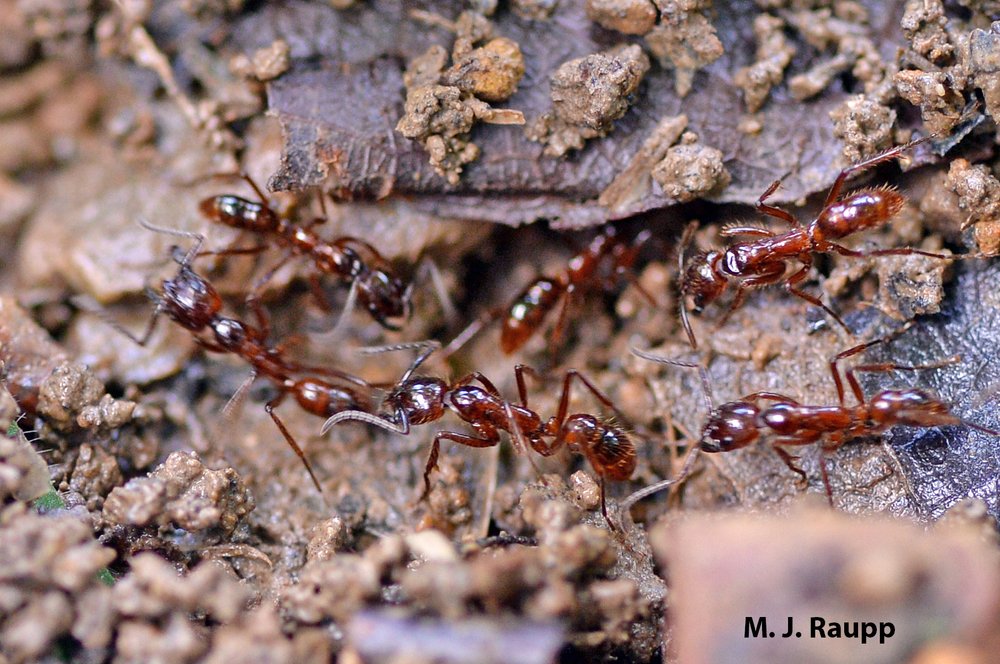Rainforest raiders: Fierce Leptogenys ants

On the rainforest floor, a column of Leptogenys workers like this one transport food to the colony and help relocate the colony from one hunting zone to another.
This week we return to the rainforests of Borneo in the spectacular Tabin Wildlife Reserve where we met millipedes, stingless bees, and lanternflies in previous episodes. Here on the rainforest floor several hundred species of ants can be found, but one of the most ferocious members of the ant clan are the predatory ants in the genus Leptogenys. Although Leptogenys share many characteristics with their army ant cousins which we met in the rainforests of Costa Rica, they are members of a different subfamily of ants known as the Ponerinae. They contrast to the true army ants that are members of the subfamily Dorylinae. Despite their taxonomic distinction, they share many attributes in common with true army ants, not the least of which is their ability to conduct massive swarm raids to plunder an impressive variety of prey as food for their colony. Their smorgasbord includes a wide variety of prey – small invertebrates like spiders, centipedes, millipedes, earth worms, flatworms, and many insects, and some vertebrates including frogs and snakes.
Life and death in Tabin Wildlife Reserve includes fierce Leptogenys ants that plunder several kinds of prey on the rainforest floor. A slow-motion video clip of the frenetic column reveals several workers with unidentified insects clamped tightly in their jaws. Are these other ants, termites, or some tasty insect morsal? The lens fails to reveal. Moments later along the same column, the band of sisters transport a tattered moth back to the nest to fill the hungry mouths of waiting ant larvae and the queen mother.

Cooperation is the name of the game when sister Leptogenys capture prey like this moth and move it back to the nest.
Leptogenys colonies can be massive with more than 50,000 workers attending the colony and its queen. Swarm raids to capture food for the colony may consist of tens of thousands of workers. The raid begins at dusk when workers leave the nest to forage during the night. The raiding column begins as a single line of workers which then bifurcates repeatedly to form a massive fan-shaped front of terror that may span as much as 300 square meters of rainforest floor. When a worker encounters potential prey, a massive attack ensues as scores of workers rapidly respond to subdue the prey. The bites and wicked stings of hundreds of nestmates immobilize the victim. Using sharp, powerful jaws, workers dismember the prey and transport the pieces of meat back to the nest to feed the queen and developing brood. Less savory body parts such as wings and legs may be discarded.
As prey are expunged from one part of the rainforest, the colony is regularly relocated and remains in the same location for only a few days. The emigration from an old site to a new one is an orderly process where helpless pupae and larvae are the first to be carried to the new nest site by workers. Young workers bring up the rear. The queen is also part of the entourage, while a picket line of wary workers guards the route as the colony moves to its new location. Famed entomologist and sociobiologist E. O. Wilson once remarked “ants have the most complicated social organization on earth next to humans.” We could learn something about cooperation by watching Leptogenys at work. Stay tuned for more ant stories from Borneo at Bug of the Week.
Acknowledgements
Several great articles including “A South East Asian Ponerine of the Genus Leptogenys (Hym., Form.) with Army Ant Life Habits” by U. Maschwitz, S. Steghaus-Kovac, R. Gaube and H. Hänel, and “Topology of the foraging trails of Leptogenys processionalis – Why are they branched?” by K.N. Ganeshaiah and T. Veena provided insight into Leptogenys, as did “The Ants” by Bert Hölldoppler and Edward O. Wilson. We thank Oliver at Tabin Wildlife Reserve for braving rainforest trails to help us find insects and the keen eyes of Dan, Kristie, Bob, Pat, and Paula for spotting insects. Special thanks to Chien C. Lee at Wild Borneo Photography for help in identifying the star of this episode.
This post appeared first on Bug of the Week